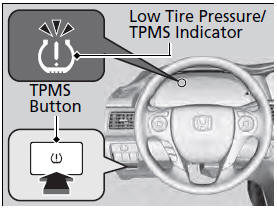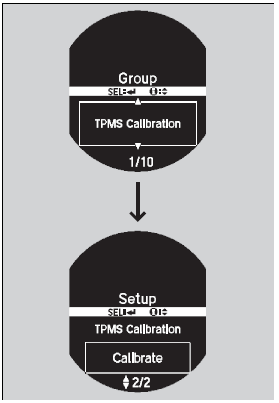 Honda Accord: TPMS (Tire Pressure Monitoring System)
Honda Accord: TPMS (Tire Pressure Monitoring System)
Instead of directly measuring the pressure in each tire, the TPMS on this vehicle monitors and compares the rolling radius and rotational characteristics of each wheel and tire while you are driving to determine if one or more tires are significantly under-inflated. This will cause the low tire pressure/TPMS indicator to come on and a message to appear on the multi-information display*.
The system does not monitor the tires when driving at low speed.
Conditions such as low ambient temperature and altitude change directly affect tire pressure and can trigger the low tire pressure/TPMS indicator to come on.
Tire pressure checked and inflated in:
• Warm weather can become under-inflated in
colder weather.
• Cold weather can become over-inflated in warmer
weather.
The low tire pressure indicator will not come on as a result of over inflation.
The TPMS may not function properly if tire type and size are mixed. Make sure to use the same size and type of tire.
The low tire pressure/TPMS indicator may come on with a delay or may not come on at all when:
• You rapidly accelerate, decelerate, or turn the
steering wheel.
• You drive on snowy or slippery roads.
• Snow chains are used.
The low tire pressure/TPMS indicator may come on under the following conditions:
• A compact spare tire is used.
• There is a heavier and uneven load on the tires,
such as when towing a trailer, than the condition at
calibration.
• Snow chains are used.
• TPMS Calibration
You must start TPMS calibration every time you:
• Adjust the pressure in one or more tires.
• Rotate the tires.
• Replace one or more tires.
Before calibrating the TPMS:
• Set the cold tire pressure in all four tires.
Make sure:
• The vehicle is at a complete stop.

• The shift lever is in (N.

• The shift lever is in (P.

• The ignition switch is in ON  .
.


Press and hold the TPMS button until the low tire pressure/TPMS indicator blinks twice, indicating the calibration process has begun.
• If the low tire pressure/TPMS indicator does
not blink, confirm the above conditions
then press and hold the TPMS button again.
• The calibration process finishes
automatically.


You can calibrate the system from the customized features on the multi-information display.
1. Press  button to select
Vehicle
Settings, then press the SEL/RESET button.
button to select
Vehicle
Settings, then press the SEL/RESET button.
- TPMS Calibration appears on the display.
2. Press the SEL/RESET button.
- The display switches to the
customization setup screen, where you
can select Cancel or Calibrate.
3. Press the  button and select
Calibrate, then press the SEL/RESET button.
button and select
Calibrate, then press the SEL/RESET button.
- Calibration Started screen appears,
then the display returns to the
customization menu screen.
• If the Calibration Failed to Start message
appears, repeat steps 2-3.
• The calibration process finishes automatically.
• TPMS cannot be calibrated if a compact spare tire is
installed.
• The calibration process requires approximately 30
minutes of cumulative driving at speeds between
30-60 mph (48-97 km/h).
• During this period, if the ignition is turned on and
the vehicle is not moved within 45 seconds, you
may notice the low tire pressure indicator comes on
briefly. This is normal and indicates that the
calibration process is not yet complete.
You can calibrate the system using the audio/ information screen.
If the snow chains are installed, remove them before calibrating the TPMS.
If the low tire pressure/TPMS indicator comes on even when the properly inflated specified regular tires are installed, have the vehicle checked by a dealer.
We recommend that the tires be replaced with the same brand, model, and size as the originals. Ask a dealer for details.

 LaneWatch TM*
LaneWatch TM*
Is an assistance system that allows you to check the passenger side rear
areas
displayed on the audio/information screen when the turn signal is activated to
the
passenger’s side. A camera i ...
 Tire Pressure Monitoring System (TPMS) -Required Federal Explanation
Tire Pressure Monitoring System (TPMS) -Required Federal Explanation
Each tire, including the spare (if provided), should be checked monthly when
cold and inflated to the inflation pressure recommended by the vehicle
manufacturer on the vehicle placard or tire infl ...
See also:
Control Locations
Control Locations ...
Synchronized Mode
You can set the temperature synchronously for the driver side and the
passenger
side in synchronized mode.
1. Press the SYNC button.
- The system will switch to the synchronized mode.
...
System Description
General Description
The automatic transmission is a transverse-mounted three-shaft design,
implemeting an electronically controlled
hydraulic circuit that provides five forward speeds and one in r ...
